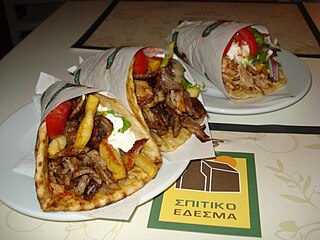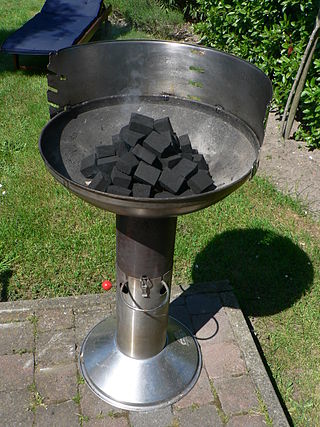
Turkish cuisine is the cuisine of Turkey and the Turkish diaspora. Although the cuisine took its current rich form after numerous cultural interactions throughout centuries, it should not be confused with other cuisines such as Ottoman cuisine or Seljuk cuisine. Turkish cuisine with traditional Turkic elements such as yogurt, ayran, kaymak, exerts and gains influences to and from Mediterranean, Balkan, Middle Eastern, Central Asian and Eastern European cuisines.

A skewer is a thin metal or wood stick used to hold pieces of food together. The word may sometimes be used as a metonym, to refer to the entire food item served on a skewer, as in "chicken skewers". Skewers are used while grilling or roasting meats and fish, and in other culinary applications.

Gyros, sometimes anglicized as a gyro in some regions, is meat cooked on a vertical rotisserie, then sliced and served wrapped or stuffed in pita bread, along with other ingredients such as tomato, onion, fried potatoes, and tzatziki. In Greece, it is normally made with pork or sometimes with chicken, whilst beef and lamb are also used in other countries.

Shashlik, or shashlyck, is a dish of skewered and grilled cubes of meat, similar to or synonymous with shish kebab. It is known traditionally by various other names in Iran, the Caucasus, Eastern Europe and Central Asia, and from the 19th century became popular as shashlik across much of the Russian Empire and nowadays in the Russian Federation and former Soviet Union republics.

Kebab, kabob, or kebap or kabab is roasted meat that originates from the Middle East and has been popularised by Iranian cuisine and Turkish cuisine. Many variants of the category are popular around the world, including the skewered shish kebab and the doner kebab with bread.

Doner kebab, also spelled as döner kebab, is a dish of Turkish origin made of meat cooked on a vertical rotisserie. Seasoned meat stacked in the shape of an inverted cone is turned slowly on the rotisserie, next to a vertical cooking element. The operator uses a knife to slice thin shavings from the outer layer of the meat as it cooks. The vertical rotisserie was invented in the 19th-century Ottoman Empire, and dishes such as the Arab shawarma, Greek gyros, Canadian donair, and Mexican al pastor are derived from this.

Ćevapi, ćevapčići is a grilled dish of minced meat found traditionally in the countries of southeast Europe. It is considered a national dish of Bosnia and Herzegovina and Serbia, with Bosnia and Herzegovina taking steps in branding and placing them on the entity and a state list of intangible heritage, with a nomination for inclusion on the UNESCO List of Intangible Cultural Heritage under way. The ćevap is also common in Albania, Bulgaria, Croatia, Kosovo, Montenegro, North Macedonia, and Slovenia.

Sosatie is a traditional South African dish of meat cooked on skewers. The term derives from sate and saus. It is of Cape Malay origin, used in Afrikaans, the primary language of the Cape Malays, and the word has gained greater circulation in South Africa. Marinated, cubed meat is skewered and cooked by braaing (barbecued) shish-kebab style. Sosatie recipes vary, but commonly the ingredients can include cubes of lamb, beef, chicken, dried apricots, red onions and mixed peppers.

Barbecue varies by the type of meat, sauce, rub, or other flavorings used, the point in barbecuing at which they are added, the role smoke plays, the equipment and fuel used, cooking temperature, and cooking time.

Seekh kebab is a type of kebab, native to the Indian subcontinent, made with Indian spices, spiced minced or ground meat, usually lamb, beef, or chicken, formed into cylinders on skewers and grilled. It is typically cooked on a mangal or barbecue, or in a tandoor. Seekh kebabs are prepared in homes and restaurants throughout Pakistan. It is a signature dish in Indian metro cities like Bhopal, Delhi, Hyderabad, and Lucknow, but they can be found all over India.

Kokoretsi or kokoreç is a dish of the Balkans and Anatolia, consisting of lamb or goat intestines wrapped around seasoned offal, including sweetbreads, hearts, lungs, or kidneys, and typically grilled; a variant consists of chopped innards cooked on a griddle. The intestines of suckling lambs are preferred.

Shish kofta (Turkish) is a type of kebab-style kofta dish in Turkish cuisine.

Shish taouk or shish tawook is a traditional marinated chicken shish kebab of Ottoman cuisine that later became part of Middle Eastern cuisine. It is widely eaten in the Middle East and Caucasus. A similar dish in Persian cuisine is the traditional jujeh kabab. It is also served in kebab houses in many cities around the world.

Cağ kebabı is a horizontally stacked marinated rotating lamb kebab variety, originating in Erzurum Province, Turkey.

Patlıcanlı kebap (also known as patlıcan kebabı, English: eggplant kebab, is a Turkish kebab that may be prepared according to various traditions.

Çöp şiş is a type of lamb shish kebab eaten throughout Anatolia in Turkey.




















